Learning how to make starch from corn may be useful for many beginner bakers! Using simple materials, you can create an environmentally friendly substitute for traditional starches, such as wheat flour or potato starch.
This article will show you how to make starch from corn at home.
What Is Cornstarch?
Cornstarch is a refined carbohydrate made from the endosperm of corn kernels. It is a white, powdery substance often used as a thickening agent in cooking and baking applications.
Cornstarch has been around since ancient times and was first derived by Native Americans who ground it into flour for making bread and cakes.
Today, cornstarch is widely used in commercial food products and is often added to gravies, sauces, soups and stews to thicken them. It can also be used as a coating for fried foods such as chicken nuggets or fish sticks.
In baking applications, it helps create gluten-free products by replacing wheat flour. Cornstarch can also dust bread and pastries as a clouding agent in ice creams and other frozen desserts.
Cornstarch is an inexpensive ingredient that has many useful applications in the kitchen. However, it is important to note that cornstarch cannot replace flour in all baking recipes since it lacks the gluten content found in flour.
It is also important to use cornstarch correctly to avoid ruining a recipe, as too much can make a dish slimy or gummy.
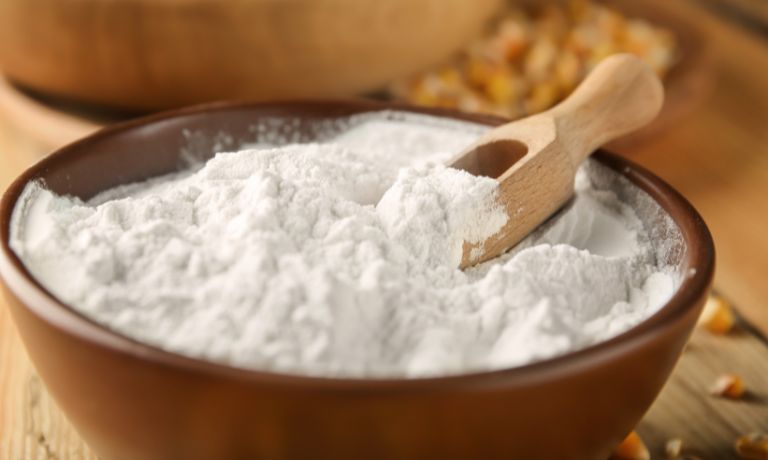
Cornstarch
Different Cornstarch Types And Their Uses
Cornstarch is a versatile, starch-based powder that can be used in various ways. It has many different types, and each type’s uses depend on the specific application.
– The most common type of cornstarch is called “floury” or regular cornstarch. As its name implies, this cornstarch is a fine powder that can be used as a thickening agent in sauces, soups and gravies. It is also commonly used to make puddings and pie fillings.
– Another type of cornstarch is called “waxy” or modified cornstarch. This type of starch has been chemically modified and is more resistant to high temperatures than regular cornstarch. This makes it ideal for use in foods that require high cooking temperatures, such as deep-fried dishes or pastries.
– The third type of cornstarch is called “instant” or pregelatinized cornstarch. As its name implies, this type of cornstarch is designed to thicken liquids quickly and easily. It is often used in custards, puddings and other dishes that require a smooth texture with minimal stirring or cooking time.
– Finally, there is “free-flowing” or dextrinized cornstarch, which has been processed to make it more resistant to lumping. This type of cornstarch is often used in gravies, sauces and soups that require a smooth texture without lumps. It also works well in baked goods such as muffins or cakes.
Benefits Of Starch From Corn In Cooking And Baking
Cornstarch is one of the most widely used starches in cooking and baking. It has several advantages that make it a popular choice for many recipes.
Cornstarch can be used as a thickening agent, allowing chefs to create sauces, gravies, soups, puddings and other dishes with a smooth, consistent texture. Cornstarch is also used in batters for fried foods, such as chicken nuggets and fish sticks, to help create a crunchy exterior.
Cornstarch helps prevent gluten from forming in baking and can be used in cake recipes to make them light and fluffy. Cornstarch is inexpensive compared to other thickeners and can be stored long without losing effectiveness.
Additionally, cornstarch has no flavor, so it does not affect the overall taste of a dish. Its neutral nature also makes combining various ingredients and work into different recipes easier. Cornstarch is an essential ingredient in your pantry for cooking and baking.
Cornstarch is also known for its nutritional benefits as well. It is relatively low in calories compared to other starches and contains a good amount of dietary fiber, protein, calcium, iron, phosphorus, magnesium, niacin and thiamine.
Cornstarch also has an impressive amount of carbohydrates, which can help provide the body with energy. All these nutrients make cornstarch a great addition to any meal or snack.
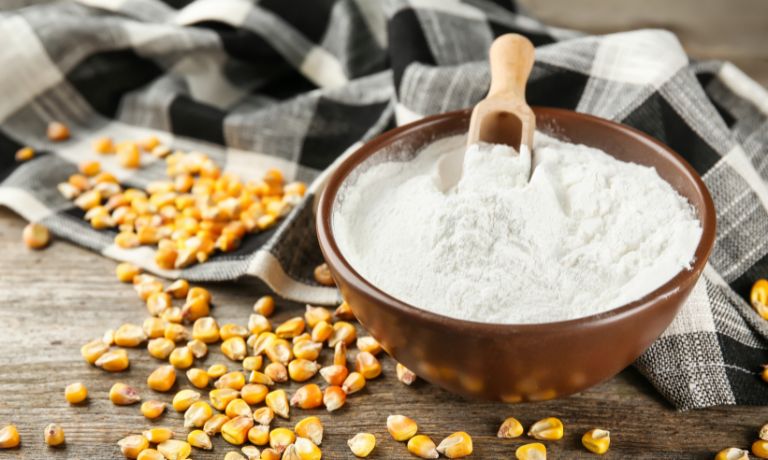
Cornstarch and kernels
How Does Starch From Corn Work?
Cornstarch is made from the endosperm of corn kernels, which is the inner part of the kernel.
When moistened, it forms a thick paste that can be used as a thickener or binding agent. Cornstarch absorbs liquid and then expands when heated to form a gel-like substance. This gel helps thicken sauces and prevents them from separating.
It is also used to give fried foods a crunchy coating. Cornstarch helps create light and fluffy cakes, muffins, and other baked goods when baking.
As a general rule of thumb, use two tablespoons of cornstarch for every cup of liquid when thickening sauces or gravies. When baking, one teaspoon of cornstarch can be used for every cup of flour.
Cornstarch is often used with other starches, such as arrowroot or tapioca starch, to achieve the desired consistency in a recipe.
The combination helps provide a more balanced and consistent texture than just one type of starch. Cornstarch is also a good choice for gluten-free baking, as it is naturally gluten-free.
How To Make Starch From Corn?
Making starch from corn is a straightforward process that yields a versatile, natural product.
- To make your starch, start with yellow dent corn or waxy maize. These types of corn contain the highest levels of amylose, the type of carbohydrate used to produce starch.
- Soak your corn in water for four hours. This will help soften the kernels and prepare them for milling. Use a corn grinder or food processor to grind the soaked corn into a fine powder.
- Bring four cups of water to a boil in a large pot. Add one cup of ground cornmeal and stir until completely dissolved, then lower the heat and simmer for 15 minutes, stirring occasionally. Pour the mixture into a fine-meshed strainer over a pot or bowl and discard any remaining lumps of corn meal.
- Allow the strained liquid to cool, pour it back into your pot, and heat until it is below boiling. Slowly stir in 1/2 cup of cold water and continue stirring for 10 minutes to encourage starch grains to settle out of the liquid.
- Carefully pour the mixture into a strainer lined with cheesecloth or a dampened kitchen towel and allow it to drain for several hours. Gently gather up the edges of the cloth and squeeze the remaining moisture from your homemade starch.
- Allow your starch to dry completely before storing it in an airtight container. Use your homemade cornstarch as a thickener for gravies, sauces and soups, or make a versatile paste for craft projects.
What Types Of Corn Should You Choose To Make Starch?
You should consider corn types when learning how to make starch from corn. When making starch, you should choose a variety of corn high in amylopectin, which is the type of starch used for thickening and binding.
Amylose corn varieties are more resistant to cooking and break down slower than those with higher amylopectin content. Some of the best varieties of corn for making starch include flint corn, dent corn, and sweet corn.
Flint corn has a large kernel with hard outer shells and is the type of dried maize most commonly used for making Masa Harina, a traditional Mexican flour made from ground-dried corn kernels. It contains more amylopectin than other varieties of maize, making it ideal for making a thicker, dryer starch.
Dent corn is another variety of maize commonly used in cornmeal, grits and Masa Harina. It has a larger kernel than flint corn and contains more amylopectin, making it great for thickening and binding applications.
Sweet corn is the corn most commonly eaten as a vegetable but can also be used to make starch. It has a higher amylose content than flint and dent corn, so it breaks down faster when cooked, which is ideal for creating a smooth consistency in sauces or soups.
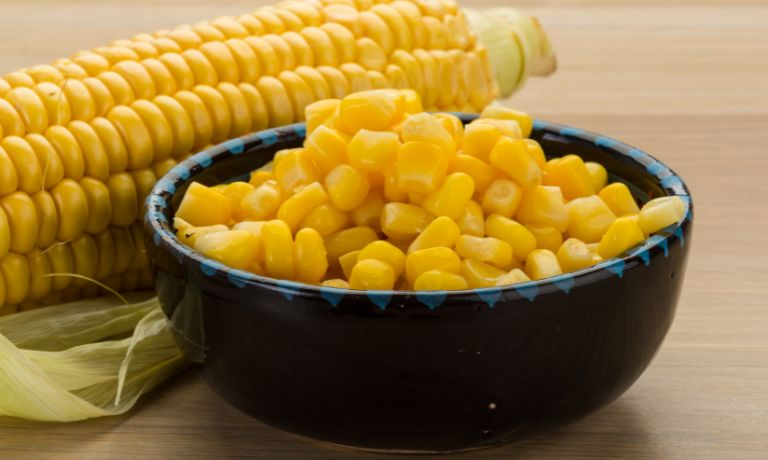
Sweet corn
Substitutes For Starch From Corn
Cornstarch is most commonly used as a thickening agent for sauces and gravies, but plenty of other ingredients can be used in its place.
– Potato starch is one of the best substitutes for cornstarch, with many chefs preferring it since it provides more consistent results. It has twice the thickening power of cornstarch and is gluten-free, making it an ideal choice for those with dietary restrictions.
– Arrowroot is another great substitute for cornstarch that provides a neutral flavor, making it perfect for dishes where you don’t want the starch to overpower other flavors. It also has twice the thickening power of cornstarch and is gluten-free.
– Tapioca starch is a great substitute for cornstarch with a slightly sweet flavor, making it ideal for desserts and sauces. It’s also gluten-free and provides the same thickening power as cornstarch.
– Rice flour is an excellent substitute for cornstarch that can be used in both savory and sweet recipes. It doesn’t have the same thickening power as cornstarch, but it still works great for sauces, puddings, and custards.
These are just some of the cornstarch substitutes you can use in your cooking. While they may not have the same thickness or flavor profile as cornstarch, they are still great options when you need something quick and easy. You can find the perfect substitute for your recipes with a little experimentation.
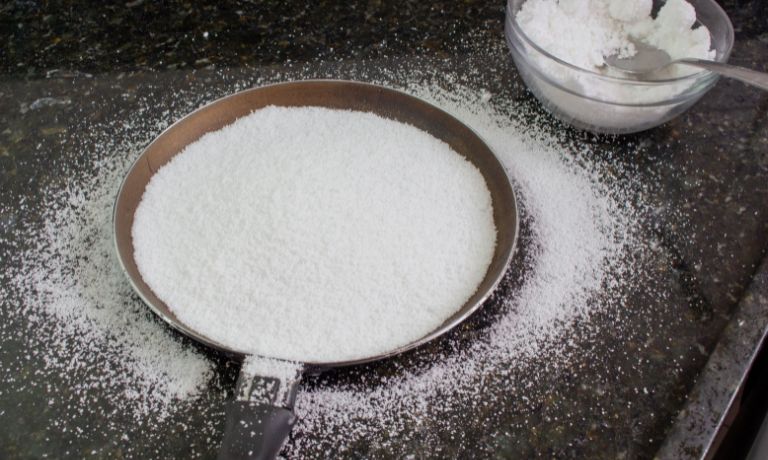
Tapioca starch
Differences Between Starch From Corn And Flour From Wheat
Starch and flour are both important ingredients in food preparation. Corn starch and wheat flour have different properties, making them ideal for various recipes.
– Cornstarch is a white powder made from corn kernels, while wheat flour is made by grinding the endosperm of wheat grains. Both have common applications, such as thickening sauces, binding ingredients together and providing texture to food.
Cornstarch is mostly used as a thickening agent due to its high starch content. When added to hot liquids, the starch molecules swell, forming an invisible gel thickening the mixture.
Cornstarch requires very little cooking time and produces a smooth, glossy finish. It is also used in baking recipes to lighten the texture and add crispness.
– Wheat flour, on the other hand, contains protein which helps give structure to baked goods like bread and cakes. The gluten protein derived from wheat gives a chewy texture to these products.
Wheat flour requires longer cooking times than cornstarch and produces a more matte finish. It is also less effective as a thickening agent than cornstarch, making it unsuitable for some sauces.
Both cornstarch and wheat flour are important ingredients in food preparation. However, they should be used carefully depending on the desired outcome of the dish.
How Should You Store Starch From Corn?
Once you have harvested your corn, you should store the starch from it in an airtight container. This helps preserve its freshness and prevents it from spoiling quickly.
Keep the container in a cool, dark place, such as a pantry or cupboard, away from direct sunlight. You can also store the starch in the freezer for longer-term storage; this will help extend its shelf life.
When transferring the starch from the container to your cooking vessel, ensure it is handled carefully and not exposed to too much air or heat, as this could cause the starch to spoil quickly.
If storing in the refrigerator, be sure to use it within one week of being opened. Storing starch properly will ensure you can enjoy its benefits for a long time.
Recipes Using Starch From Corn
Corn is a versatile and delicious ingredient used to make various recipes. Starch from corn is an especially common ingredient in many dishes, adding flavor and texture to the meal. Here are some recipes that use starch from corn for added flavor and nutrition:
- Cornbread – This classic recipe is made with cornmeal and some starch from corn. The result is a fluffy, slightly sweet loaf that pairs well with chili or stews.
- Corn Fritters – These are made with shredded potatoes, cornstarch, and herbs. Fried in oil until golden brown, these crispy snacks are perfect for sharing.
- Corn Soup – This creamy soup is made with a combination of corn, potatoes, and starch from corn. The result is a hearty bowl that’s perfect for cold weather nights.
- Corn Chowder – This is a classic comfort food dish made with cream and cornstarch. The result is a great thick, creamy soup with a side of crusty bread.
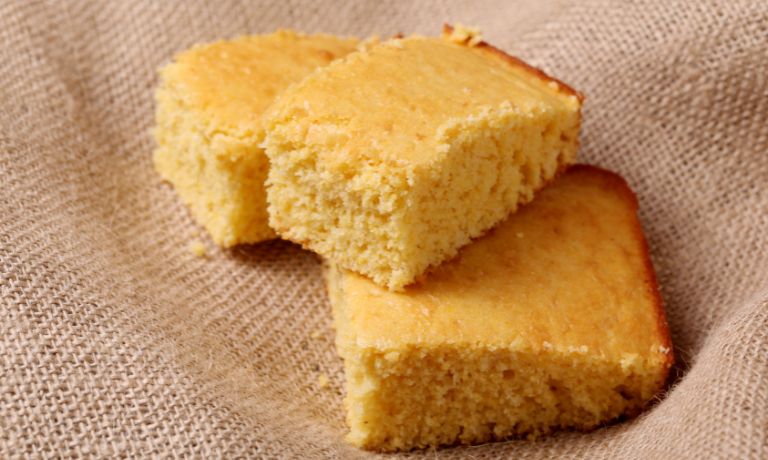
Cornbread
Common Mistakes To Avoid About How To Make Starch From Corn
To help ensure that you have a successful experience with making your own cornstarch, we will cover the most common mistakes people make when attempting to learn how to make starch from corn!
- Not soaking the corn kernels in water: When making starch from corn, it is necessary to soak the corn kernels overnight in cold water. This enables them to become soft and easier to process into a paste. Please soak the kernels to avoid an unsatisfactory outcome or difficulty breaking down the starch granules.
- Skipping the sieving process: After grinding or mashing the corn, it is important to pass it through a sieve to separate any debris and small particles that may have been missed during milling. This will ensure the starch has a finer texture and is free of any contaminants.
- Using too much water: When making starch from corn, it is important to add just the right amount of water. Too much can create a thin paste that will not be suitable for use in cooking or baking recipes. On the other hand, too little can result in a paste that is difficult to stir and unsuitable for most cooking applications.
- Not using a food processor: If you are looking for the finest texture, using a food processor or blender to break down the corn kernels is essential. This process can be done by hand but requires more time and effort than a machine.
With these tips, you can successfully create your starch from corn!
FAQs
Can Corn Starch Be Frozen?
Yes, cornstarch can be frozen. It’s important to note that freezing can affect the texture and performance of corn starch, so it’s best to use it immediately after thawing or store it in the refrigerator for up to three days before using.
Do You Use Hot Or Cold Water To Combine Cornstarch?
You can use hot or cold water to combine cornstarch with the other ingredients. Hot water will dissolve the starch faster but may also diminish its thickening ability.
If you use cornstarch in a recipe that requires heat, dissolve it in cold water before adding it to the other ingredients. This will help maintain the thickening power of the starch.
Can Milk Be Used To Make Cornstarch Instead Of Water?
No, milk should not be used to make cornstarch instead of water.
Milk contains protein and fat, which can interfere with the thickening power of the starch molecules in cornstarch, resulting in an unsatisfactory end product.
Water is still the best option for making a smooth, creamy cornstarch slurry or sauce.
What Might I Substitute For Starch From Corn?
If you don’t have access to corn or would like to use something else, you can use a few other alternatives. In recipes, arrowroot powder, tapioca starch, and potato starch are good substitutes for cornstarch.
Can Starch From Corn Spoil?
Starch from corn can spoil if it is exposed to air and moisture. To prevent spoilage, store your starch in an airtight container.
Additionally, you can keep your starch in the refrigerator or freezer for an even longer shelf life.
Is Starch From Corn And Flour From Corn Interchangeable Terms?
No, starch from corn and flour from corn are not interchangeable terms.
Cornstarch is a very fine powder made from the inner part of the kernel, while corn flour is made by grinding up whole kernels and can be much coarser in texture.
How Can Starch From Corn Be Used?
Starch from corn can be used in a variety of ways. It can be used to thicken sauces and gravies, as a substitute for flour in baking, or as an ingredient in coating mixtures for deep frying.
Additionally, it can be used as a natural thickening agent in many recipes.
What Procedure Is Used To Prepare Starch From Corn?
The procedure for preparing starch from corn involves the following steps:
- The cobs are removed, and the kernels are shelled to obtain raw corn.
- The raw corn is washed with cold water to remove dirt or debris.
- The washed corns are then milled to obtain a fine powder.
- The milled corn is soaked in hot water for 10-15 minutes to soften the kernels.
- After that, the softened corns are milled again to get a fine paste that contains the starch granules.
- Finally, the starch granules are collected by sieving the paste and then dried in the sun.
How Should Homemade Starch From Corn Be Prepared For Cooking?
When preparing homemade starch from corn, it is important to ensure it has been processed correctly.
The most common way of processing is by boiling and mashing the corn kernels until they form a starchy paste.
Once prepared, this paste can be used instead of regular cornstarch when making gravies, sauces, or thickening other recipes.
How Is Cornstarch Prepared Instantly?
Cornstarch can be prepared instantly by grinding dry corn kernels into a powder.
This is an easy and simple way to make a quick slurry for cooking recipes for cornstarch. The powder should then be mixed with water to form a paste which can then be cooked in place of regular cornstarch.
Conclusion: How To Make Starch From Corn?
Now you should know how to make starch from corn. Making starch from corn is a fairly simple process that requires few ingredients and minimal effort.
It involves soaking the corn in water, separating the kernels from the cob and grinding them into a paste. The paste is then boiled until it thickens slightly and cools before being spread out to dry.
Once completely dried, the starch can be used in various recipes. This process is an effective way to make starch from corn while also preserving its flavor and nutrition without having to worry about added preservatives or chemicals.
Making starch from corn can be a fun way to enjoy all the benefits of this versatile grain without spending too much money. Moreover, it is a great way to add a healthy, natural ingredient to all of your favorite dishes.


